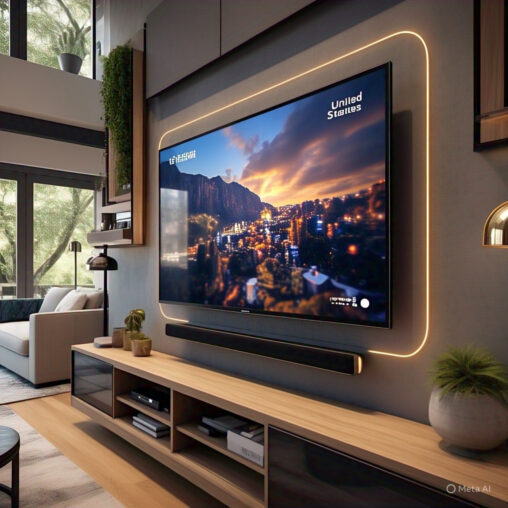Title: United States Smart TV Market Set to Reach US$ 134.97 Billion by 2033, Driven by Streaming Boom and Smart Home Integration
According to a recent industry analysis, the United States Smart TV Market is projected to grow significantly, rising from US$ 54.95 billion in 2024 to US$ 134.97 billion by 2033, reflecting a compound annual growth rate (CAGR) of 10.50% during the forecast period (2025–2033). This surge is fueled by the exploding popularity of streaming services, rising adoption of smart home ecosystems, and rapid advancements in television display and operating system technologies.
United States Smart TV Market Analysis (2025–2033)
Market Introduction
Smart TVs, which combine internet-connected capabilities with traditional television functions, have become the epicenter of home entertainment in the United States. This transformation is shaped by evolving consumer media consumption habits, particularly among younger demographics, and the increasing penetration of high-speed internet across American households.
The industry encapsulates a wide spectrum of television offerings, from basic streaming-capable HD sets to high-end OLED and QLED models. In addition to hardware, software ecosystems—especially those powered by Android, Roku, and proprietary systems like Tizen and WebOS—are playing a critical role in shaping the user experience.
Key Market Drivers
- Rise of Streaming Culture
The shift away from traditional cable toward digital content is redefining the television landscape. With over 60% of Americans under age 30 preferring to stream content rather than use cable or satellite, Smart TVs have become the go-to portal for on-demand content. Subscription-based platforms like Netflix, Hulu, Disney+, and Amazon Prime Video are influencing consumer buying behavior, leading to a spike in Smart TV sales.
- Technological Advancements
Modern Smart TVs boast high-end features such as 4K UHD, OLED, QLED, and HDR technologies, offering vivid visuals and immersive audio. Coupled with AI-driven voice assistants like Google Assistant and Alexa, and features such as content recommendations, Smart TVs are now smarter and more interactive than ever.
- Smart Home Integration
Seamless compatibility with smart home ecosystems is becoming a must-have. Users increasingly control lighting, thermostats, and security devices directly from their TVs, transforming Smart TVs into central command hubs for connected homes.
Market Challenges
- Digital Divide & Bandwidth Issues
Despite technological advances, limited broadband access in rural and low-income areas remains a key obstacle, particularly when streaming 4K or 8K content, which demands high-speed internet.
- User Interface Complexity
Smart TVs often come with sophisticated features that can overwhelm non-tech-savvy users, especially older adults. The complexity of navigating apps, using voice commands, and updating software poses a barrier to full adoption.
United States Smart TV Market Segmentation
By Resolution Type
- Full HD TV (Dominant Segment)
With the perfect balance of affordability and quality, Full HD (1080p) TVs continue to attract mass-market buyers. As HD streaming becomes the norm, Full HD is expected to maintain a substantial market share. - 4K UHD TV & 8K TV
Gaining popularity among premium consumers, especially for sports and gaming. These high-end models offer enhanced detail and superior contrast ratios.
By Screen Size
- 46 to 55 Inches (Leading Segment)
The sweet spot for U.S. households, this size category supports immersive viewing without overpowering living spaces. Growing interest in cinematic experiences at home is pushing sales in this segment. - Above 65 Inches
Demand is rising among affluent households seeking an upscale, theater-like home entertainment system.
By Type
- Flat Screen TVs (Dominant Share)
Favored for sleek design, wide availability, and affordability. Flat-screen Smart TVs continue to dominate U.S. households. - Curved TVs
Niche segment primarily targeted at gaming enthusiasts and home theater aficionados.
By Technology
- LED (Leading Segment)
Energy efficiency, affordability, and excellent brightness levels make LED TVs the most popular Smart TV technology. - QLED & OLED
Increasingly favored for their superior picture quality and deep blacks. OLED is growing fast among high-income buyers.
By Operating System
- Android TV (High Growth Segment)
Google’s Android OS offers wide app compatibility, voice control, and a smooth interface, making it a preferred choice for younger consumers and tech-savvy users. - Roku, Tizen, WebOS, and Fire TV
Each caters to specific user preferences, with Roku known for ease of use and Fire TV favored for Amazon ecosystem integration.
By Application
- Residential (Dominant Segment)
Accounting for the lion’s share of revenue, Residential Smart TVs are central to living rooms across the country, supporting streaming, gaming, video conferencing, and smart device control. - Commercial
Businesses, hotels, education, and healthcare are increasingly adopting Smart TVs for interactive and digital display purposes.
Regional Insights: United States Smart TV Market by State
The market is analyzed across major states, including:
- California: Leads the market due to its tech-savvy population and high disposable income. Home to Silicon Valley, it sees faster adoption of smart devices.
- Texas, New York, Florida: High population density and streaming service adoption make these states strong Smart TV markets.
- Illinois, Pennsylvania, Ohio: Rising smart home installations and broadband connectivity are propelling growth.
Key Market Trends
- Customized Advertising: 41% of U.S. viewers would engage more with tailored ads, opening revenue opportunities via ad-supported Smart TV platforms.
- Gamification & Cloud Gaming: Integration with platforms like NVIDIA GeForce Now and Xbox Cloud is positioning Smart TVs as a future gaming hub.
- Eco-Conscious Design: Brands are launching energy-efficient models to appeal to environmentally aware consumers.
Competitive Landscape
Leading companies operating in the U.S. Smart TV market include:
- Samsung Electronics
- LG Electronics
- Sony Corporation
- TCL Technology
- Vizio Inc.
- Hisense Group
- Panasonic Corporation
- Amazon (Fire TV)
- Google (Android TV & Chromecast)
- Roku, Inc.
These players are focusing on integrating AI features, voice assistance, exclusive app ecosystems, and better panel technologies to gain a competitive edge.
New publish Blogs :
| https://www.renub.com/top-smart-tv-companies-bd.php |
| https://www.renub.com/top-specialty-fertilizers-companies-bd.php |
| https://www.renub.com/top-tilapia-companies-bd.php |
Conclusion
The United States Smart TV Market is undergoing a transformative shift, propelled by the convergence of streaming media, smart home integration, and user-friendly interfaces. With robust consumer demand and continuous technological innovation, the market is well-positioned for dynamic growth through 2033. As Smart TVs become central to digital lifestyles, opportunities abound for manufacturers, developers, advertisers, and consumers alike.
About Renub Research
Renub Research is a leading market research and consulting company offering management consulting and in-depth industry analysis across various sectors. With a global perspective and a local understanding, Renub Research delivers insights that matter.
About the Company:
Renub Research is a Market Research and Consulting Company. We have more than 15 years of experience especially in international Business-to-Business Researches, Surveys and Consulting. We provide a wide range of business research solutions that helps companies in making better business decisions. We partner with clients in all sectors and regions to identify their highest-value opportunities, address their most critical challenges, and transform their businesses. Our wide clientele comprises major players in Healthcare, Travel and Tourism, Food Beverages, Power Energy, Information Technology, Telecom Internet, Chemical, Logistics Automotive, Consumer Goods Retail, Building, and Construction, Agriculture. Our core team is comprised of experienced people holding graduate, postgraduate, and Ph.D. degrees in Finance, Marketing, Human Resource, Bio-Technology, Medicine, Information Technology, Environmental Science, and many more.
Media Contact:
Company Name: Renub Research
Contact Person: Rajat Gupta, Marketing Manager
Phone No: +91-120-421-9822 (IND) | +1-478-202-3244 (USA)
Email: mailto:[email protected]





